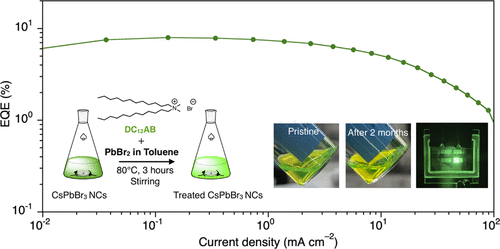当前位置:
X-MOL 学术
›
ACS Appl. Mater. Interfaces
›
论文详情
Our official English website, www.x-mol.net, welcomes your feedback! (Note: you will need to create a separate account there.)
Surface Crystal Growth of Perovskite Nanocrystals via Postsynthetic Lead(II) Bromide Treatment to Increase the Colloidal Stability and Efficiency of Light-Emitting Devices.
ACS Applied Materials & Interfaces ( IF 9.5 ) Pub Date : 2020-09-11 , DOI: 10.1021/acsami.0c13212 Takayuki Chiba 1 , Yoshihito Takahashi 1 , Jun Sato 1 , Shota Ishikawa 1 , Hinako Ebe 1 , Kota Tamura 1 , Satoru Ohisa 1 , Junji Kido 1
ACS Applied Materials & Interfaces ( IF 9.5 ) Pub Date : 2020-09-11 , DOI: 10.1021/acsami.0c13212 Takayuki Chiba 1 , Yoshihito Takahashi 1 , Jun Sato 1 , Shota Ishikawa 1 , Hinako Ebe 1 , Kota Tamura 1 , Satoru Ohisa 1 , Junji Kido 1
Affiliation

|
The surface modification of metal halide perovskite nanocrystals (NCs) significantly impacts their optical properties and colloidal stability. This subsequently affects the performance of light-emitting devices (LEDs). Therefore, numerous surface passivation techniques like ligand exchange and metal halide doping have been explored to passivate the surface defects of perovskite NCs and obtain highly efficient LEDs. In this study, we demonstrated the postsynthetic metal halide doping treatment using lead(II) bromide (PbBr2) to passivate the surface defects of the CsPbBr3 NCs at a moderate reaction temperature of 80 °C. The alkyl quaternary ammonium salt, didodecyldimethylammonium bromide (DC12AB), enabled the complete dissolution of PbBr2 in a nonpolar solvent, toluene. Because of surface crystal growth, the particle sizes of the PbBr2-doped CsPbBr3 NCs were higher than those of the as-synthesized CsPbBr3 NCs. The photoluminescence quantum yield of the CsPbBr3 NCs drastically increased from 26.8 to 83.9% after the PbBr2 doping treatment. Moreover, the PbBr2-doped CsPbBr3 NCs possessed long-term colloidal stability of more than 2 months that indicates the strong bonding between the NCs and ligands. We observed that the alkyl chain length of the quaternary alkyl ammonium salts affected the luminance and device stability during operations. In this study, a promising strategy was devised to achieve highly luminescent perovskite NCs with excellent colloidal stability that can enhance the performance of LEDs.
中文翻译:

通过合成后溴化铅(II)处理钙钛矿纳米晶体的表面晶体生长,以提高发光器件的胶体稳定性和效率。
金属卤化物钙钛矿纳米晶体(NCs)的表面改性显着影响其光学性能和胶体稳定性。随后,这会影响发光器件(LED)的性能。因此,已经探索了许多表面钝化技术(例如配体交换和金属卤化物掺杂)来钝化钙钛矿NC的表面缺陷并获得高效的LED。在这项研究中,我们证明了使用溴化铅(II)(PbBr 2)进行合成后金属卤化物掺杂处理,可在80°C的中等反应温度下钝化CsPbBr 3 NC的表面缺陷。烷基季铵盐二十二烷基二甲基溴化铵(DC 12 AB)使PbBr 2完全溶解在非极性溶剂甲苯中。由于表面晶体的生长,PbBr 2掺杂的CsPbBr 3 NCs的粒径大于合成时的CsPbBr 3 NCs的粒径。掺杂PbBr 2后,CsPbBr 3 NC的光致发光量子产率从26.8%急剧增加到83.9%。此外,PbBr 2掺杂的CsPbBr 3NCs具有超过2个月的长期胶体稳定性,表明NCs与配体之间的牢固结合。我们观察到,季烷基铵盐的烷基链长会影响操作过程中的亮度和器件稳定性。在这项研究中,设计了一种有前途的策略,以实现具有出色的胶体稳定性,可增强LED性能的高发光钙钛矿NC。
更新日期:2020-10-07
中文翻译:

通过合成后溴化铅(II)处理钙钛矿纳米晶体的表面晶体生长,以提高发光器件的胶体稳定性和效率。
金属卤化物钙钛矿纳米晶体(NCs)的表面改性显着影响其光学性能和胶体稳定性。随后,这会影响发光器件(LED)的性能。因此,已经探索了许多表面钝化技术(例如配体交换和金属卤化物掺杂)来钝化钙钛矿NC的表面缺陷并获得高效的LED。在这项研究中,我们证明了使用溴化铅(II)(PbBr 2)进行合成后金属卤化物掺杂处理,可在80°C的中等反应温度下钝化CsPbBr 3 NC的表面缺陷。烷基季铵盐二十二烷基二甲基溴化铵(DC 12 AB)使PbBr 2完全溶解在非极性溶剂甲苯中。由于表面晶体的生长,PbBr 2掺杂的CsPbBr 3 NCs的粒径大于合成时的CsPbBr 3 NCs的粒径。掺杂PbBr 2后,CsPbBr 3 NC的光致发光量子产率从26.8%急剧增加到83.9%。此外,PbBr 2掺杂的CsPbBr 3NCs具有超过2个月的长期胶体稳定性,表明NCs与配体之间的牢固结合。我们观察到,季烷基铵盐的烷基链长会影响操作过程中的亮度和器件稳定性。在这项研究中,设计了一种有前途的策略,以实现具有出色的胶体稳定性,可增强LED性能的高发光钙钛矿NC。



























 京公网安备 11010802027423号
京公网安备 11010802027423号